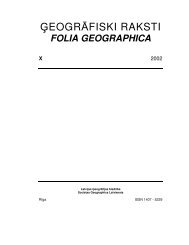eogrÄfiski raksti folia geographica xii - Ä¢eogrÄfijas un Zemes zinÄtņu ...
eogrÄfiski raksti folia geographica xii - Ä¢eogrÄfijas un Zemes zinÄtņu ...
eogrÄfiski raksti folia geographica xii - Ä¢eogrÄfijas un Zemes zinÄtņu ...
Create successful ePaper yourself
Turn your PDF publications into a flip-book with our unique Google optimized e-Paper software.
23<br />
NATURE RESEARCH<br />
interannual variations, and from year to year these phases may manifest themselves in very<br />
different versions, particularly with reference to the beginning of winter (November) and the<br />
end of winter (February).<br />
3.3. Precipitation: seasonality and interannual fluctuations<br />
The annual course of atmospheric precipitation (P) differs greatly from that of Rnt and<br />
T. The data of an 11-year period (1990-2000) show that each month can produce a very low<br />
amo<strong>un</strong>t of P, but a high amo<strong>un</strong>t may occur within only a short half-year (Figure 3).<br />
Consequently, the year may be divided into two periods which differ essentially by maximum<br />
and mean amo<strong>un</strong>ts of precipitation, but are similar in relation to minimum monthly amo<strong>un</strong>ts of<br />
P. December – April is a low precipitation period, when monthly means do not exceed<br />
30-50 mm, but the highest monthly amo<strong>un</strong>ts are 60-90 mm. J<strong>un</strong>e-October on the other hand is a<br />
period of high precipitation with monthly means aro<strong>un</strong>d 65-85 mm and the highest monthly<br />
amo<strong>un</strong>ts aro<strong>un</strong>d 110-180 mm. The transition phases between these two, in terms of<br />
precipitation, distinctive 5-month phases are May (a month, when culminant phase of Rnt sets<br />
in) and November (the starting phase of negative Rnt and the final phase of positive T).<br />
Seasons<br />
Figure 3. The highest, lowest and average amo<strong>un</strong>t of monthly mean precipitation (Riga) in the 11-year period<br />
(1990-2000). The seasons see in Figure 2 and the text<br />
In Latvia, the lowest amo<strong>un</strong>t of P is commonly observed in the phase when Rnt and T<br />
gradients are the highest – aro<strong>un</strong>d vernal equinox (March/April), and the highest amo<strong>un</strong>t varies<br />
spatially and in time. In coastal areas (Liepaja and Riga) the highest monthly amo<strong>un</strong>ts have<br />
been registered during the phase of Rnt and T decline, primarily after autumnal equinox<br />
(October), but in inland regions generally aro<strong>un</strong>d summer solstice (J<strong>un</strong>e/July). However, the<br />
yearly minima and maxima of P are very <strong>un</strong>certain in time, and in different locations these<br />
manifest themselves in different ways.<br />
In Riga, which is located on the coast of Riga Bay, but from three sides (east, south and<br />
west) is encircled by land, the lowest amo<strong>un</strong>t of precipitation for the year during the 11-year<br />
study period was observed in 8 months (twice in April, May and November, once in, February,<br />
March, July, August and December). Yet April and May are the driest months (minimum<br />
monthly amo<strong>un</strong>ts ca 5-15 mm, monthly means 30-35 mm and the highest amo<strong>un</strong>t 65 mm).<br />
According to long-term data, these months also show the least number of days with measurable<br />
precipitation (12-13 days per month), the greatest number of days with clear skies and the<br />
lowest relative humidity at the surface (Table 2). The described pattern partly lasts <strong>un</strong>til May,<br />
but the first low-precipitation months December and January are radically different – the

















